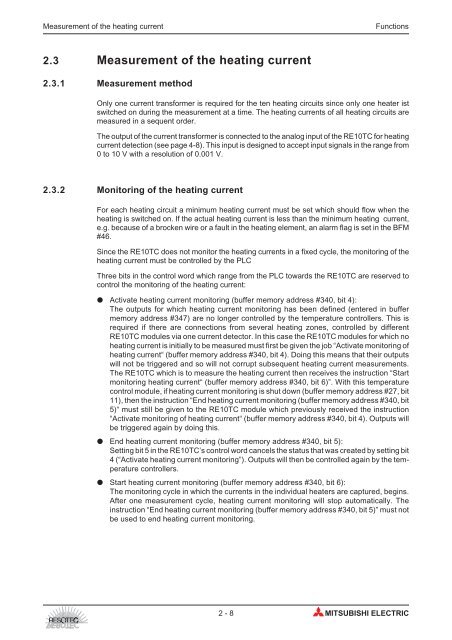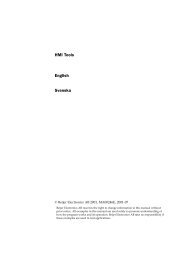RE10TC Temperature Control Module Operating manual
RE10TC Temperature Control Module Operating manual
RE10TC Temperature Control Module Operating manual
You also want an ePaper? Increase the reach of your titles
YUMPU automatically turns print PDFs into web optimized ePapers that Google loves.
Measurement of the heating current Functions<br />
2.3 Measurement of the heating current<br />
2.3.1 Measurement method<br />
Only one current transformer is required for the ten heating circuits since only one heater ist<br />
switched on during the measurement at a time. The heating currents of all heating circuits are<br />
measured in a sequent order.<br />
The output of the current transformer is connected to the analog input of the <strong>RE10TC</strong> for heating<br />
current detection (see page 4-8). This input is designed to accept input signals in the range from<br />
0 to 10 V with a resolution of 0.001 V.<br />
2.3.2 Monitoring of the heating current<br />
For each heating circuit a minimum heating current must be set which should flow when the<br />
heating is switched on. If the actual heating current is less than the minimum heating current,<br />
e.g. because of a brocken wire or a fault in the heating element, an alarm flag is set in the BFM<br />
#46.<br />
Since the <strong>RE10TC</strong> does not monitor the heating currents in a fixed cycle, the monitoring of the<br />
heating current must be controlled by the PLC<br />
Three bits in the control word which range from the PLC towards the <strong>RE10TC</strong> are reserved to<br />
control the monitoring of the heating current:<br />
� Activate heating current monitoring (buffer memory address #340, bit 4):<br />
The outputs for which heating current monitoring has been defined (entered in buffer<br />
memory address #347) are no longer controlled by the temperature controllers. This is<br />
required if there are connections from several heating zones, controlled by different<br />
<strong>RE10TC</strong> modules via one current detector. In this case the <strong>RE10TC</strong> modules for which no<br />
heating current is initially to be measured must first be given the job “Activate monitoring of<br />
heating current“ (buffer memory address #340, bit 4). Doing this means that their outputs<br />
will not be triggered and so will not corrupt subsequent heating current measurements.<br />
The <strong>RE10TC</strong> which is to measure the heating current then receives the instruction “Start<br />
monitoring heating current“ (buffer memory address #340, bit 6)”. With this temperature<br />
control module, if heating current monitoring is shut down (buffer memory address #27, bit<br />
11), then the instruction “End heating current monitoring (buffer memory address #340, bit<br />
5)“ must still be given to the <strong>RE10TC</strong> module which previously received the instruction<br />
“Activate monitoring of heating current“ (buffer memory address #340, bit 4). Outputs will<br />
be triggered again by doing this.<br />
� End heating current monitoring (buffer memory address #340, bit 5):<br />
Setting bit 5 in the <strong>RE10TC</strong>’s control word cancels the status that was created by setting bit<br />
4 (“Activate heating current monitoring”). Outputs will then be controlled again by the temperature<br />
controllers.<br />
� Start heating current monitoring (buffer memory address #340, bit 6):<br />
The monitoring cycle in which the currents in the individual heaters are captured, begins.<br />
After one measurement cycle, heating current monitoring will stop automatically. The<br />
instruction “End heating current monitoring (buffer memory address #340, bit 5)” must not<br />
be used to end heating current monitoring.<br />
2-8 MITSUBISHI ELECTRIC




